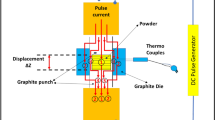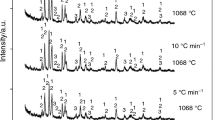Abstract
AgI-SiO2 hybrid powders (HPs) based on SBA-15, MCM-41, and MCM-48 have been prepared by template co-condensation of silica and silver iodide under hydrothermal conditions. The effect of the [Ag]/[Si] ratio and the type of silica matrix on the textural, structural, morphological, and rheological properties of the HPs has been studied. The formation of the target phase of iodargyrite (β-AgI) is dependent both on the ratio of the main components [Ag]/[Si] and on the pore arrangement in the silica matrix, as detected by XRD. The small-angle XRD and low-temperature nitrogen adsorption data have shown the textural and structural properties of AgI-SiO2 hybrid powders to be similar to the porous structure of the initial silica matrices—SBA-15, MCM-41, or MCM-48. A uniform distribution of silver iodide in all silica matrices, SBA-15, MCM-41 and MCM-48, has been demonstrated by energy dispersive microanalysis (EDAX). For AgI-SiO2 powders with various types of pore arrangement, a high fluidity degree has been demonstrated using the data on the natural angle of repose. It has been shown that MCM-48 based β-AgI-SiO2 powders are characterized by the smallest crystallite sizes (~6 nm), and average size of particles (50 nm) and average size of particle aggregates (13 μm), the highest specific surface area (up to 860 m2/g) and the best fluidity.
Graphical Abstract

Highlights
-
The formation of the target β-AgI phase, iodargyrite, in AgI-SiO2 hybrid powders (HP) depends both on the component [Ag]/[Si] ratio and on the pore arrangement type of the silica matrix.
-
Crystal phase, corresponding to iodargyrite, was detected in HPs samples prepared using the [Ag]/[Si] ratios within the range from 0.04 to 0.08.
-
In AgI-SiO2 powders prepared by hydrothermal template synthesis via а co-condensation route, the ordered pore arrangement was found to be similar to that of the initial silica matrices—SBA-15, MCM-41 or MCM-48.
-
The smallest crystallites (~6 nm), average size of particles (50 nm) and average size of particle aggregates (13 μm), the highest specific surface area (up to 860 m2/g), and the best fluidity was found in the case of β-AgI-SiO2 powders based on the MCM-48 matrix.







Similar content being viewed by others
References
Feigelson EM (1984) In: Feigelson EM (ed) Radiation in a Cloudy Atmosphere. Springer, Dordrecht.
Khain A, Pinsky M (2018) In: Khain A (ed) Physical processes in clouds and cloud modeling. Cambridge University Press, USA.
Mangan TP, Plane MC, Murray BJ (2021) The phase of water ice which forms in cold cloud in the mesospheres of Mars, venus and Earth. JGR Planets 126. https://doi.org/10.1029/2020JE006796
Quante M, Matthias V (2006) Water in the Earth’s atmosphere. J Phys IV Fr 139:37–61. https://doi.org/10.1051/jp4:2006139005
Dennis AS (1980) Weather modification by cloud seeding. Academic Press, USA
Malik S, Bano H (2018) Cloud seeding; Its prospects and concerns in the modern world-a review. Int J Pure App Biosci 6:791–796
Perez-Diaz JL (2017) Fogs: Physical basis, characteristics properties, and impacts on the environment and human health. Water. https://doi.org/10.3390/w9100807
Edwards GR, Evans LF (1960) Ice nucleation efficiency by Frezzeng vs sublimation. J Meteorol 17:627–634
Fukuta N, Paik Y (2014) Water adsorption and ice nucleation on silver iodide surfaces. Appl Phys 44:1092–1110
Fitzner M, Sosso GC, Cox SJ, Michaelides A (2015) The many faces of heterogeneous ice nucleation: Interplay between surface morphology and hydrophobicity. J Am Chem Soc 137:13658–13669
Zielke SA, Bertram AK (2015) A molecular mechanism of ice nucleation on model AgI Surface. J Phys Chem B 119:9049–9055
Zhang J (2011) Preparation of nano-silver iodide powders and their efficiency as ice-nucleating agent in weather modification. Adv Powder Technol 22:613–616
Gan YX, Jayatissa AH, Yu Z, Chen X, Li M (2020) Hydrothermal Synthesis of Nanomaterials. J Nanomaterials. https://doi.org/10.1155/2020/8917013
Sacramento RA, Cysneiros OMS, Silva BJB, Silva AOS (2019) Synthesis and characterization of mesoporous materials with SBA and MCM structure types. Ceramics. https://doi.org/10.1590/0366-69132019653762628
Hoffmann F, Cornelius M, Morell J, Froba M (2006) Silica-based mesoporous organic-inorganic hybrid materials. Angew Chem 45:3216–3261
Linssen T, Cassiers K, Cool P, Vansant EF (2003) Mesoporous templated silicates: an overview of their synthesis, catalytic activation and evaluation of the stability. Adv Colloid Interface Sci 103:121–147
Xu Y, Huang S, Ji H, Jing L, He M, Xu H, Zhang Q, Li H (2016) Facile synthesis of CNT/AgI with enhanced photocatalytic degradation and antibacterial ability. RSC Adv 6:6905–6914. https://doi.org/10.1039/C5RA24620B
Ghosh S, Saraswathi A, Indi SS, Hoti SL, Vasan HN (2012) Ag@AgI, core@shell structure in agarose matrix as hybrid: synthesis, characterization, and antimicrobial activity. Langmuir https://doi.org/10.1021/la301322j
Gupta PN, Singh A, Kulshrestha N, Kharwar RN (2017) Studies on PVA/AgI Based Polymeric Membranes for Exploration of Antibacterial Activity. Int J Polym Mater. https://doi.org/10.1080/00914037.2017.1320662
Guo BW, Huang L, Deng P, Xue Z (2001) Characterization of BetaAl-MCM-41 composite molecular sieve compared with the mechanical mixture. Micropor Mesopor Mater 44-45:427–434
Guo CW, Kong L, Ha CS, Li Q (2003) Enhanced acidity and hydrothermal stability of mesoporous aluminosilicate with secondary building units characteristic of zeolite Beta. Stud Surf Sci Catal 146:307–310
Li R, Fan W, Ma J, Xie K (2000) Preparation of Y/MCM-41 composite materials. Stud Surf Sci Catal 129:117–120
Beers AEW, Nijihuis TA, Kapteijn F, Moulijn JA (2001) Zeolite coated structures for the acylation of aromatics. Micropor Mesopor Mater 48:279–284
Karlsson A, Stocker M, Schafer K (2000) In situ synthesis of micro- and mesoporous Al-MFI/MCM-41 like phases with high hydrothermal stability. Stud Surf Sci Catal 129:99–106
Karlsson A, Stocker M, Schmidt R (1999) Composites of micro- and mesoporous materials: simultaneous syntheses of MFI/MCM-41 like phases by a mixed template approach. Micropor Mesopor Mater 27:181–192
Landau ML, Tavor D, Regev O (1999) Colloidal Nanocrystals of Zeolite b Stabilized in Alumina Matrix. Chem Mater 11:2030–2037
Prokesova P, Mintova S, Cejka J, Bein T (2003) Preparation of Nanosized Micro/Mesoporous Composites via Simultaneous Synthesis of Beta/MCM-48 Phases. Micropor Mesopor Mater V. 64:165–174
Kinger G, Majda D, Vinek H (2002) n-Heptane hydroisomerization over Pt-containing mixtures of zeolites with inert materials. Appl Catal 225:301–312.
Ziolek M, Nowak I, Sobczak I, Poltorak H (1999) The possible use of mesoporous molecular sieves for deodorization. Stud Surf Sci Catal 125:691–698
Pao KSJH (2003) Study of preparation and properties of nano-scale AgI-porous SiO2 composites. J Chin Ceramic Soc 31:246–249
Groen JC, Peffer LAA, Perez-Ramirez J (2003) Pore size determination in modified micro- and mesoporous materials. Pitfalls and limitations in gas adsorption data analysis. Microp Mesopor Mater 60:1–17. https://doi.org/10.1016/S1387-1811(03)00339-1
Funding
The reported study was supported by the Government of Perm Krai, research project No. С-26/542.
Author information
Authors and Affiliations
Corresponding author
Ethics declarations
Conflict of interest
The authors declare no competing interests.
Additional information
Publisher’s note Springer Nature remains neutral with regard to jurisdictional claims in published maps and institutional affiliations.
Rights and permissions
Springer Nature or its licensor (e.g. a society or other partner) holds exclusive rights to this article under a publishing agreement with the author(s) or other rightsholder(s); author self-archiving of the accepted manuscript version of this article is solely governed by the terms of such publishing agreement and applicable law.
About this article
Cite this article
Averkina, A.S., Kondrashova, N.B., Saenko, E.V. et al. Comparative study of texture and rheological properties of AgI-SiO2 hybrid powders with different pore structure. J Sol-Gel Sci Technol 108, 339–351 (2023). https://doi.org/10.1007/s10971-023-06086-x
Published:
Issue Date:
DOI: https://doi.org/10.1007/s10971-023-06086-x




